The Bulldozer Review: AMD FX-8150 Tested
by Anand Lal Shimpi on October 12, 2011 1:27 AM ESTPower Management and Real Turbo Core
Like Llano, Bulldozer incorporates significant clock and power gating throughout its design. Power gating allows individual idle cores to be almost completely powered down, opening up headroom for active cores to be throttled up above and beyond their base operating frequency. Intel's calls this dynamic clock speed adjustment Turbo Boost, while AMD refers to it as Turbo Core.
The Phenom II X6 featured a rudimentary version of Turbo Core without any power gating. As a result, Turbo Core was hardly active in those processors and when it was on, it didn't stay active for very long at all.
Bulldozer's Turbo Core is far more robust. While it still uses Llano's digital estimation method of determining power consumption (e.g. the CPU knows ALU operation x consumes y-watts of power), the results should be far more tangible than what we've seen from any high-end AMD processor in the past.
Turbo Core's granularity hasn't changed with the move to Bulldozer however. If half (or fewer) of the processor cores are active, max turbo is allowed. If any more cores are active, a lower turbo frequency can be selected. Those are the only two frequencies available above the base frequency.
AMD doesn't currently have a Turbo Core monitoring utility so we turned to Core Temp to record CPU frequency while running various workloads to measure the impact of Turbo Core on Bulldozer compared to Phenom II X6 and Sandy Bridge.
First let's pick a heavily threaded workload: our x264 HD benchmark. Each run of our x264 test is composed of two passes: a lightly threaded first pass that analyzes the video, and a heavily threaded second pass that performs the actual encode. Our test runs four times before outputting a result. I measured the frequency of Core 0 over the duration of the test.
Let's start with the Phenom II X6 1100T. By default the 1100T should run at 3.3GHz, but with half or fewer cores enabled it can turbo up to 3.7GHz. If Turbo Core is able to work, I'd expect to see some jumps up to 3.7GHz during the lightly threaded passes of our x264 test:
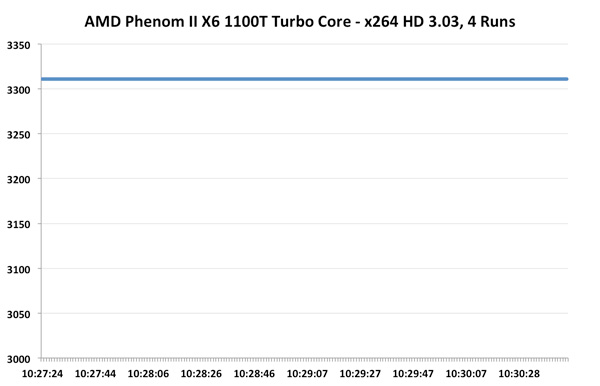
Unfortunately we see nothing of the sort. Turbo Core is pretty much non-functional on the Phenom II X6, at least running this workload. Average clock speed is a meager 3.31GHz, just barely above stock and likely only due to ASUS being aggressive with its clocking.
Now let's look at the FX-8150 with Turbo Core. The base clock here is 3.6GHz, max turbo is 4.2GHz and the intermediate turbo is 3.9GHz:
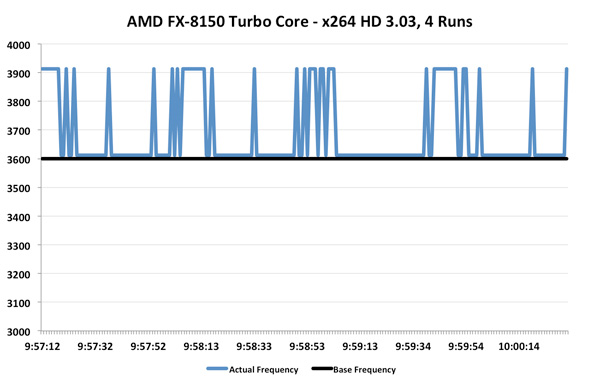
Ah that's more like it. While the average is only 3.69GHz (+2.5% over stock), we're actually seeing some movement here. This workload in particular is hard on any processor as you'll see from Intel's 2500K below:
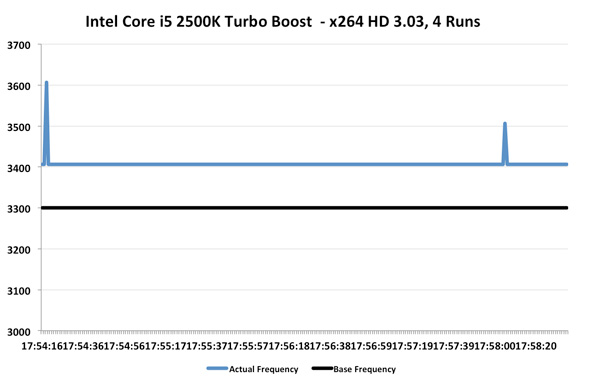
The 2500K runs at 3.3GHz by default, but thanks to turbo it averages 3.41GHz for the duration of this test. We even see a couple of jumps to 3.5 and 3.6GHz. Intel's turbo is a bit more consistent than AMD's, but average clock increase is quite similar at 3%.
Now let's look at the best case scenario for turbo: a heavy single threaded application. A single demanding application, even for a brief period of time, is really where these turbo modes can truly shine. Turbo helps launch applications quicker, make windows appear faster and make an easy time of churning through bursty workloads.
We turn to our usual favorite Cinebench 11.5, as it has an excellent single-threaded benchmark built in. Once again we start with the Phenom II X6 1100T:
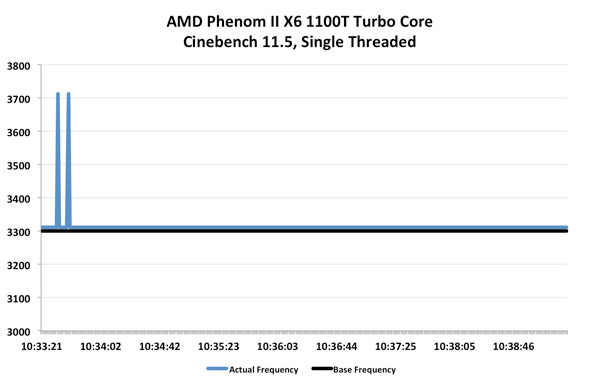
Turbo Core actually works on the Phenom II X6, albeit for a very short duration. We see a couple of blips up to 3.7GHz but the rest of the time the chip remains at 3.3GHz. Average clock speed is once again, 3.31GHz.
Bulldozer does far better:

Here we see blips up to 4.2GHz and pretty consistent performance at 3.9GHz, exactly what you'd expect. Average clock speed is 3.93GHz, a full 9% above the 3.6GHz base clock of the FX-8150.

Intel's turbo fluctuates much more frequently here, moving between 3.4GHz and 3.6GHz as it runs into TDP limits. The average clock speed remains at 3.5GHz, or a 6% increase over the base. For the first time ever, AMD actually does a better job at scaling frequency via turbo than Intel. While I would like to see more granular turbo options, it's clear that Turbo Core is a real feature in Bulldozer and not the half-hearted attempt we got with Phenom II X6. I measured the performance gains due to Turbo Core across a number of our benchmarks:

Average performance increased by just under 5% across our tests. It's nothing earth shattering, but it's a start. Don't forget how unassuming the first implementations of Turbo Boost were on Intel architectures. I do hope with future generations we may see even more significant gains from Turbo Core on Bulldozer derivatives.
Independent Clock Frequencies
When AMD introduced the original Phenom processor it promised more energy efficient execution by being able to clock each core independently. You could have a heavy workload running on Core 0 at 2.6GHz, while Core 3 ran a lighter thread at 1.6GHz. In practice, we felt Phenom's asynchronous clocking was a burden as the CPU/OS scheduler combination would sometimes take too long to ramp up a core to a higher frequency when needed. The result, at least back then, was that you'd get significantly lower performance in these workloads that shuffled threads from one core to the next. The problem was so bad that AMD abandoned asynchronous clocking altogether in Phenom II.
The feature is back in Bulldozer, and this time AMD believes it will be problem free. The first major change is with Windows 7, core parking should keep some threads from haphazardly dancing around all available cores. The second change is that Bulldozer can ramp frequencies up and down much quicker than the original Phenom ever could. Chalk that up to a side benefit of Turbo Core being a major part of the architecture this time around.
Asynchronous clocking in Bulldozer hasn't proven to be a burden in any of our tests thus far, however I'm reluctant to embrace it as an advantage just yet. At least not until we've had some more experience with the feature under our belts.


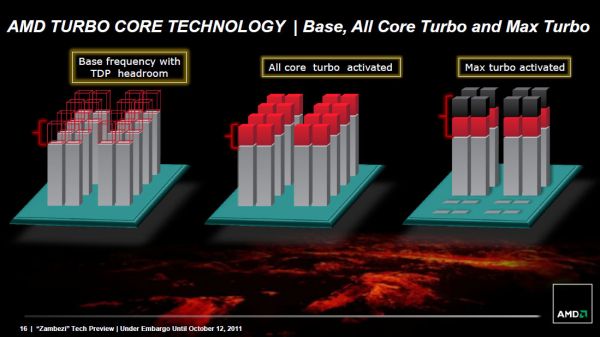








430 Comments
View All Comments
Ryan Smith - Wednesday, October 12, 2011 - link
Good point. Fixed.Marburg U - Wednesday, October 12, 2011 - link
they have a bloating cache with something wrong insidehttp://www.xbitlabs.com/images/cpu/amd-fx-8150/t5....
npp - Wednesday, October 12, 2011 - link
Sun went an even more extreme route regarding FP performance on its Niagara CPUs - as far as I remember, the first generation chip had a single FPU shared across eight cores. Performance was not even close to a dual-core Core 2 Duo at that time. So that was what I though when I first read about the "module" approach in Bulldozer maybe an year ago - man, this must be geared towards server workloads primary, it will suffer on the desktop. I guess FPU count = core count would have be more appropriate for the FX line.hasu - Wednesday, October 12, 2011 - link
Would this be a good candidate for web server applications because of its excellent multi-threaded performance? How about to host a bunch of Virtual Machines?sep332 - Wednesday, October 12, 2011 - link
I've also been wondering if running a lot of VMs would work better on this CPU. But I don't really know how you'd benchmark that kind of thing. Time and total energy consumption to serve 20,000 web pages from 12 VMs?magnetik - Wednesday, October 12, 2011 - link
I've been waiting for this moment for months and months.Reading the whole thing now...
themossie - Wednesday, October 12, 2011 - link
This processor is worse than the Phenom II X6 for most of my workloads. My next machine will be Sandy/Ivy Bridge.But... we haven't seen this clock ramp up yet. As Anand mentions on page 3 - Remember the initial Pentium 4s? The Williamette 1.4 and 1.5 ghz processors were clearly worse than the competition, to say nothing of the PIII line. In time the P4 consistently beat the much higher IPC AMD processors on most workloads, especially after introducing Hyper-threading. This really does feel like a new Pentium IV! Trying a design based on clock speed and one-upping Intel's hyperthreading by calling 4 '1.5' cores 8 (we hyperthread your hyperthreading!) - it will be a wild ride.
At this point, I don't see anyone beating Intel at process shrink and they're a moving target. But competitive pricing, quick ramp up and a few large server wins can still save the day. Dream of crazy clockspeeds :-)
themossie - Wednesday, October 12, 2011 - link
Upon further reflection...- Expect to see Bulldozer targeted towards servers and consumers who think "8 cores" sounds sexy, at least until clockspeed ramps up.
- Processor performance is not the limiting factor for most consumer applications. AMD will push APUs very heavily, something they can beat Intel at. Piledriver should drive a good price/performance bargain for OEMs, and for laptops may have idle power consumption in shouting distance of Sandy Bridge.
I'm more optimistic about AMD now. But my next machine will still be Sandy Bridge / Ivy Bridge.
wolfman3k5 - Wednesday, October 12, 2011 - link
I see people that say that they'll be waiting for Piledriver. Why not wait for AMD Drillbit, or AMD Dremel? How about AMD Screwdriver or AMD Nailpuller? Tomorrow my 2600K arrives. I'm done. I had a build ready with a ASUS 990FX ready for Bulldozer, but I will "bulldoze" the part back to NewEgg.I must admit, I was worried when I saw the large amounts of L2 cache before the launch. AMD engineers must have been taking the summer off, and decided to throw more cache at the problem. AMD needs a new engineering team. Why the hell can Intel get it right and they can't?
AMD, your CPU engineers are lazy and incompetent. I mean, it only took you "only" four years to get your own version of the Pentium 4.
The bottom line is that its time to fire your lazy retarded and incompetent engineers, and scout for some talent. That's what every other company does that wants to succeed, regardless of the industry. I mean, look at KIA and Hyundai for example, they went out and hired the best designers from Audi and the best engineers they could buy with money. Throw some more money at the problem AMD and solve your problems. And if those lazy fat fucks in Texas that you call engineers don't deliver, look somewhere else. Israel or Russia maybe? Who knows... Just my 2 cents.
IKeelU - Wednesday, October 12, 2011 - link
I know nothing of AMD employee's work ethic, but...their problems may have nothing to do with raw technical talent. But you are right about one thing - throwing money at a problem can be helpful, and that's likely why Intel has succeeded for so long. Intel has a lot of cash, and a lot of assets (such as equipment). They can afford the best design/debugging tools (whether they buy'em or make'em), which makes it much easier to develop a top product given the same amount of microchip engineering talent.And just because they're based in Texas doesn't mean their staff is all-American. Like most US tech firms, quite a bit of their talent was probably imported.